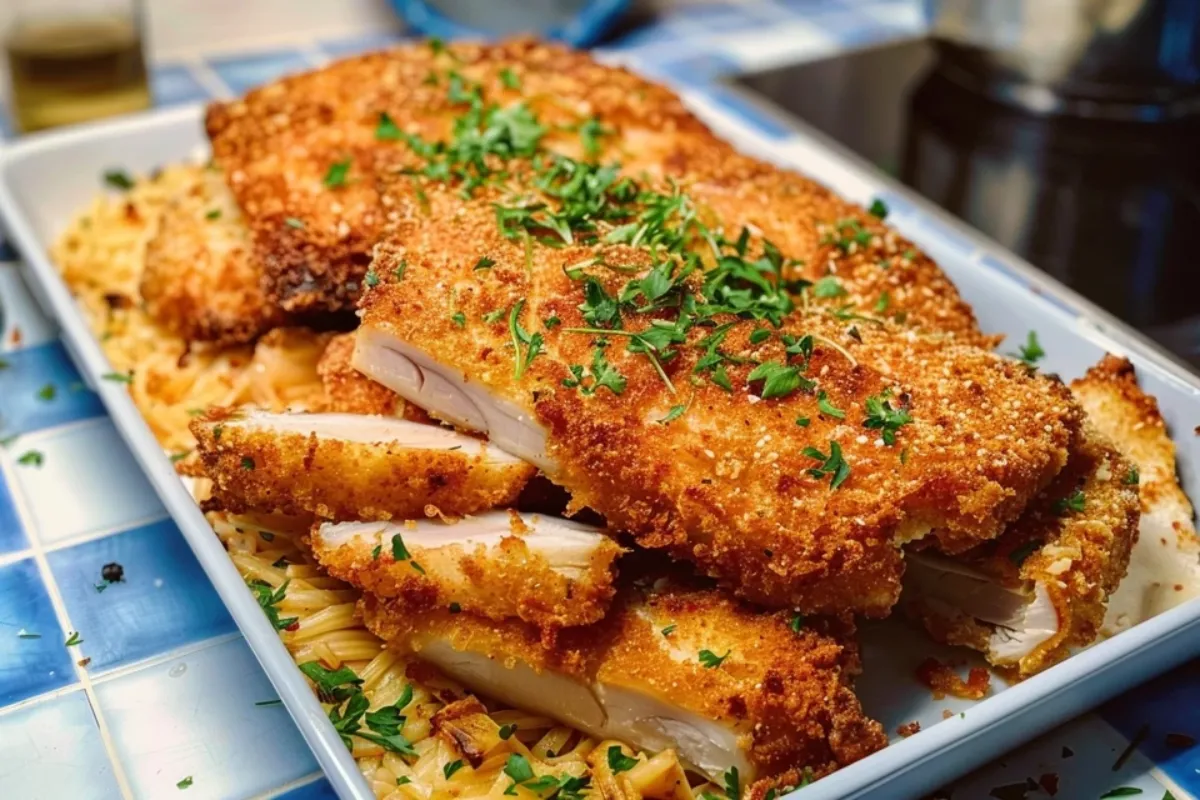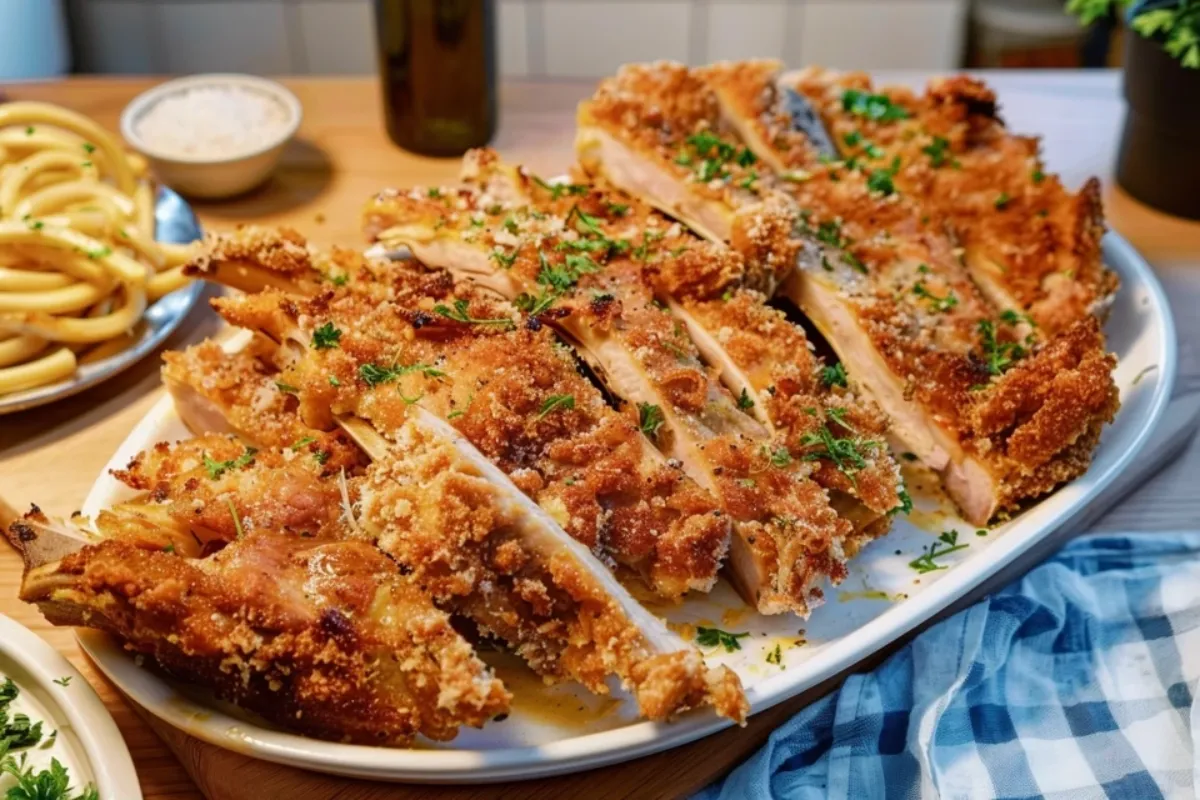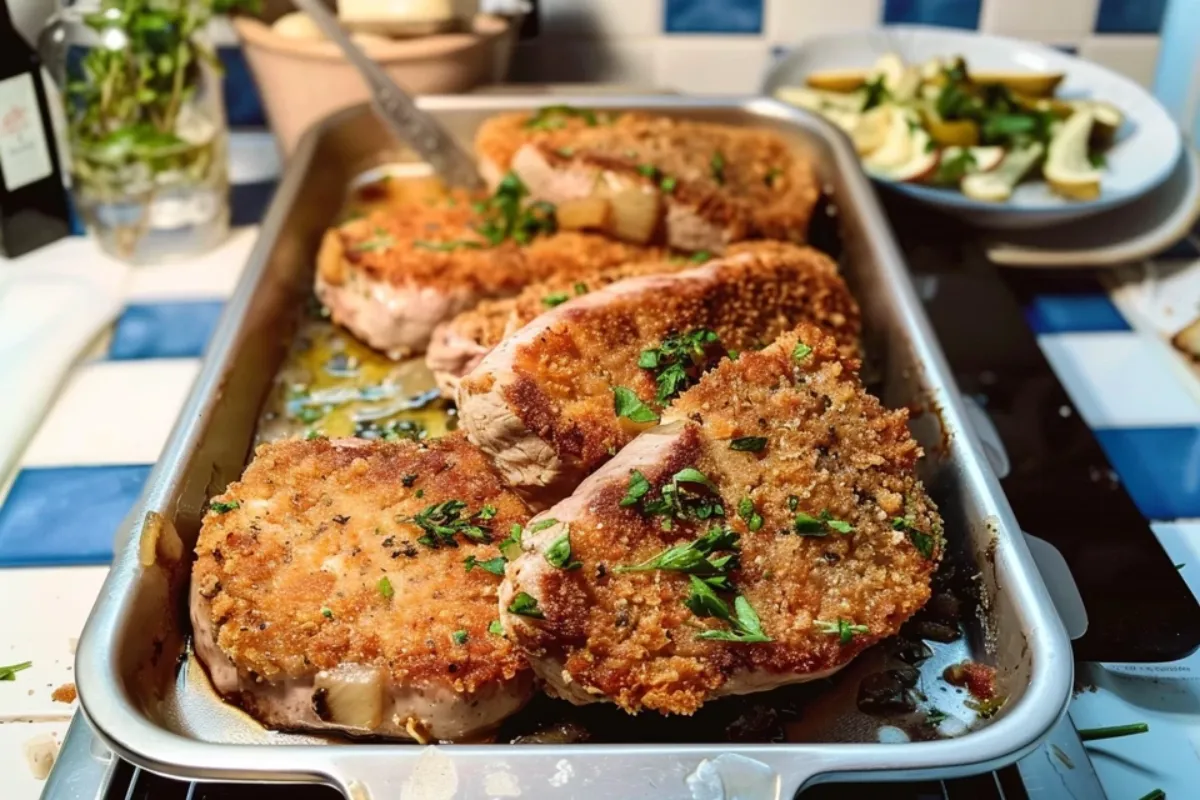What is escalope made of: An escalope is a thin, boneless cut of meat, often breaded and pan-fried. This article explores what goes into making a perfect escalope, from the choice of meat to preparation techniques.
Understanding the Basics of Escalope
Escalope, a term primarily used in European cuisine, refers to a thin slice of meat. Escalopes are usually made from veal, pork, chicken, or sometimes turkey. The meat is either gently pounded to tenderize it or cut thinly, ensuring a quick and even cooking process. Moreover, the process often involves breading before frying, although some escalopes are simply pan-fried. This technique creates a delightful crisp exterior while maintaining a juicy interior. Accordingly, understanding the components of an escalope is essential to mastering its preparation.
Different Meats Used for Escalopes
Escalopes are incredibly versatile due to the variety of meats they can be made from. Basically, each type brings a unique flavor and texture to the dish.
-
Veal Escalope: Chiefly, the classic choice, using tender veal cutlets.
-
Pork Escalope: A more affordable option that delivers a rich flavor.
-
Chicken Escalope: A leaner option, very popular for its lighter taste.
-
Turkey Escalope: Similar to chicken but with a slightly different flavor profile.
The Importance of Thinness
The key feature of an escalope is its thinness. Undoubtedly, this allows for quick cooking, preventing the meat from drying out. Specifically, this thin cut also maximizes the surface area, enabling the breading to crisp perfectly. Ultimately, a thinner slice cooks faster and more evenly, leading to a superior culinary experience.
How to Prepare an Escalope
Preparing an escalope involves a few crucial steps to ensure the best outcome. Generally, the preparation process is quite straightforward if you follow these steps carefully.
Slicing or Pounding the Meat
The initial step requires careful attention. Initially, you will want to either slice the meat thinly or gently pound it. Furthermore, if you are using a thicker cut, you will pound it to achieve the desired thinness. Subsequently, place the meat between two pieces of plastic wrap to protect it during pounding. Accordingly, use a meat mallet or rolling pin to gently flatten it to an even thickness, about ¼ to ⅓ of an inch. Therefore, this ensures even cooking and a tender result.
Bread Crumb Coating Process
Escalopes are commonly breaded before cooking. First, prepare three separate shallow dishes. First, dish one contains flour, the second has beaten eggs, and the third has breadcrumbs. Basically, season each station with salt and pepper for flavor. Afterward, dredge the pounded meat in flour, then dip it into the beaten egg, and finally coat it with breadcrumbs. Ultimately, the even coating provides a delicious crispy texture when cooked.
Cooking the Escalope
Once breaded, it is time to cook. First, heat a skillet over medium-high heat with butter or oil. Next, place the breaded escalope in the hot skillet and cook for approximately 2 to 4 minutes on each side. Furthermore, ensure the meat is golden brown and fully cooked. Moreover, be careful not to overcrowd the pan. Finally, you will need to cook the escalopes in batches if necessary to maintain the pan’s temperature.
Escalope Variations and Regional Differences
The way escalope is made may vary depending on region and personal preference. Additionally, different cultures have incorporated their own twist on the classic dish.
Veal Escalope: The Traditional Approach
Veal escalope, often referred to as Wiener Schnitzel, is perhaps the most well-known version. Comparatively, it showcases the delicate flavor of veal. Typically, this version is seasoned simply, focusing on the quality of the meat. Specifically, it is breaded and fried to a golden brown, typically served with a lemon wedge.
Pork Escalope: A Heartier Option
Pork escalope presents a more robust flavor. Indeed, the use of pork creates a different taste profile compared to veal. Consequently, this variation is sometimes served with a richer sauce. Basically, pork offers a satisfying meal for those preferring a heartier flavor.
Chicken and Turkey Escalopes: Lighter Alternatives
Chicken and turkey escalopes provide lighter options. Furthermore, these leaner meats cook quickly, offering a healthier choice. Equally, they can be flavored in various ways, making them versatile. Eventually, these lighter alternatives allow for more creative variations.
Regional Recipes
Regional variations exist across Europe. For example, Italy offers variations like cotoletta alla Milanese. Likewise, each region adds its own culinary flair, using different spices or accompaniments. Specifically, these regional differences enhance the diversity of the escalope globally.
Serving Suggestions for Escalope
Escalopes are incredibly versatile and can be served with a variety of sides. Altogether, the perfect side dish complements the rich flavors of the escalope itself.
Classic Side Dishes
-
Potatoes: For example, mashed potatoes, roasted potatoes, or potato salad.
-
Vegetables: Steamed asparagus, green beans, or a fresh salad.
-
Lemon: A simple lemon wedge is often served with traditional escalopes.
Sauces to Complement Escalopes
-
Mushroom sauce: A rich, creamy mushroom sauce elevates the dish.
-
Lemon butter sauce: A classic pairing for veal and chicken escalopes.
-
Gravy: A flavorful gravy is a great addition to pork escalope.
How to Present Escalope on the Plate
Presentation is key. First, place the escalope on the plate. Subsequently, add the side dish and a sauce, if desired. Then, garnish with fresh herbs or a lemon wedge to complete the look. Basically, a well-presented dish enhances the entire dining experience.
Key Ingredients and Their Role in a Perfect Escalope
Each ingredient plays a crucial part in achieving the best escalope. Therefore, selecting high-quality components is essential.
Choosing the Right Meat
-
Freshness: Specifically, always choose fresh meat.
-
Cut: Make sure it’s a suitable cut for escalope preparation.
-
Quality: The higher the quality of the meat, the better the final dish will taste.
The Importance of the Breading
-
Flour: Provides a base layer for the breadcrumbs to adhere to.
-
Eggs: Bind the breadcrumbs to the meat.
-
Breadcrumbs: Give the dish its distinctive crispy texture. Furthermore, choose fine or coarse breadcrumbs based on your preference.
Oil and Butter for Cooking
-
Oil: Provides a high smoke point and allows for even cooking.
-
Butter: Adds flavor, richness, and a golden-brown color. Comparatively, a mix of oil and butter often works best.
Table of Nutritional Value: Comparing Escalope Meats
| Nutritional Information per 4oz Serving (Approximate) | Veal Escalope | Pork Escalope | Chicken Escalope | Turkey Escalope |
| Calories | 200 | 240 | 180 | 170 |
| Protein (g) | 25 | 22 | 27 | 28 |
| Fat (g) | 10 | 15 | 7 | 6 |
| Saturated Fat (g) | 4 | 6 | 2 | 2 |
| Cholesterol (mg) | 90 | 85 | 80 | 75 |
Step-by-Step Recipe for a Classic Veal Escalope
This is a simple yet effective recipe for making a classic veal escalope. Therefore, follow each step carefully.
Ingredients:
-
4 veal cutlets
-
½ cup all-purpose flour
-
2 large eggs, beaten
-
1 cup breadcrumbs
-
Salt and pepper to taste
-
4 tablespoons butter
-
2 tablespoons vegetable oil
-
Lemon wedges for serving
Instructions:
-
Prepare the Meat: Place the veal cutlets between plastic wrap. Gently pound them to ¼ inch thickness. Season with salt and pepper.
-
Set Up Breading Stations: Place the flour in one shallow dish, the beaten eggs in another, and the breadcrumbs in the third.
-
Bread the Meat: Dredge each cutlet in flour. Then, dip it into the beaten eggs, and then coat it with breadcrumbs. Press gently to ensure the breadcrumbs adhere.
-
Cook the Escalopes: Heat the butter and oil in a large skillet over medium-high heat. Next, add the breaded cutlets to the hot pan. Do not overcrowd the pan.
-
Fry the Escalopes: Cook for 2-3 minutes per side, until golden brown and cooked through.
-
Serve: Serve the escalopes immediately with lemon wedges and your choice of sides. Meanwhile, a light salad or potatoes is a great match for this dish.
Table of Common Escalope Variations
| Name | Primary Meat | Preparation | Regional Origin | Typical Accompaniments |
| Wiener Schnitzel | Veal | Breaded and Fried | Austria | Lemon wedge, potatoes, salad |
| Cotoletta alla Milanese | Veal | Breaded and Fried | Italy | Lemon wedge, often served with risotto or vegetables |
| Escalope de Volaille | Chicken | Breaded and Fried | France | Lemon sauce, potatoes, mixed greens |
| Pork Escalope | Pork | Breaded and Fried | Germany | Mushroom sauce, spaetzle, red cabbage |
Tips for Making the Perfect Escalope
Indeed, there are several tips to consider when making this dish. Specifically, attention to detail is crucial.
Achieving Optimal Thinness
Pound the meat evenly to ensure consistent cooking. Moreover, make sure that you use a firm but gentle pounding motion. Afterward, you will get a thin and evenly cooked escalope.
Ensuring Crispy Bread Crumbs
-
Use fresh breadcrumbs: For the best texture and flavor.
-
Press gently: To ensure the breadcrumbs adhere properly.
-
Don’t overcrowd the pan: Overcrowding the pan can reduce the temperature and result in soggy breadcrumbs.
Cooking Temperature Control
-
Use Medium-high heat: For even and rapid cooking.
-
Don’t overcook: The meat should be cooked through, but still juicy.
-
Use a thermometer: If unsure, use a meat thermometer to verify the meat is cooked through.
Seasoning Techniques
-
Season throughout the process: Add salt and pepper to the flour, eggs, and breadcrumbs.
-
Marinating the meat: Consider marinating the meat for a richer flavor.
Variations and Accompaniments
Experiment with different coatings and seasonings. Additionally, try various sauces or side dishes to create unique escalope meals. Undoubtedly, this can enhance your culinary skills.
Conclusion: Mastering the Art of Escalope
The escalope, a dish characterized by its thin cut and quick preparation, is both versatile and delicious. Specifically, understanding what the escalope is made of, the different types of meats, and the crucial techniques involved enables you to make this dish flawlessly. Ultimately, from the classic veal version to lighter chicken variations, mastering the escalope is a valuable culinary skill that will surely impress any palate. Therefore, whether you are a seasoned cook or a novice in the kitchen, follow these guidelines to create perfect escalopes every time. Indeed, with a little practice, you can master the art of escalope cookery. Finally, this classic dish can become a staple in your home.
Frequently Asked Questions (FAQs)
What cut of meat is escalope?
Escalope typically uses thin, boneless cuts of meat. Specifically, these can include veal, pork, chicken, or turkey. The meat is either sliced thinly or gently pounded to achieve a uniform thickness. Moreover, this ensures quick and even cooking.
What is chicken escalope made of?
Chicken escalope is made from thinly sliced or pounded chicken breast. Specifically, it is often breaded and pan-fried. Furthermore, this preparation method results in a crispy exterior and a juicy, tender interior. Ultimately, this is a lighter and popular alternative to veal or pork.
What’s the difference between a schnitzel and an escalope?
The terms “schnitzel” and “escalope” are often used interchangeably. However, “schnitzel” typically refers specifically to a breaded and fried thin cut of veal. Comparatively, “escalope” is a broader term that can include various meats such as veal, pork, or chicken. Basically, both involve similar preparation methods. Nevertheless, in common usage, schnitzel is most frequently made with veal, and escalope is used more broadly.
Is escalope chicken or fish?
Escalope is not fish; it is a meat dish. Generally, it is made using various types of meat. Specifically, chicken, veal, pork, and turkey are common choices. Therefore, the term refers to the thin, boneless preparation style and not a particular animal protein.


